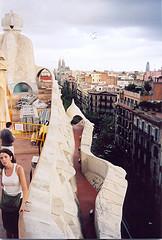 Discover the Roman Barcelona, discover the medieval history of the city, or delve into the era of the modernist geniuses can do only in the city of Barcelona. The Catalan capital have so many beautiful buildings that you can not look up if you go through their most emblematic neighbourhoods: buildings that go from Gothic to modernist, archaeological remains and ancient Barcino, which there are still vestiges and which occupied practically the same extension of the Gothic quarter in the center of the city. This beautiful area near the Cathedral of Barcelona, can also be found official buildings of the Government of Catalonia and the Barcelona History Museum. The creation of l Eixample this period there are also significant improvements, since industry prospers economically and demographically, with what the medieval walls no longer serve to defend so many inhabitants in 1860, Idelfons Cerda carried out a plan of urban development of the city: two perpendicular streets parallel to the sea that is they cut at a right angle. Today it’s l Eixample, with Diagonal and Meridiana as main axes. Thus, Barcelona will happen to occupy two hectares, i.e. twenty times the surface of the medieval city, and will see his power in Spain, same that will participate in the political and cultural of late 19th and early 20th Centuries movement: modernism. It is very advisable to stroll l Eixample, one of the most opulent area in which were the residences of the bourgeois class. There are many accommodation possibilities that you will bring to this area, as an apartment in Barcelona there is that stress during this period Joan de Borgunya worked in the polychromy of images for the convent of Santa Catalina, decorations to fresco and preparatory drawings for rain coats, the pictorial decoration of the choir, the design of a stained glass window in the Cathedral of Barcelona.
Discover the Roman Barcelona, discover the medieval history of the city, or delve into the era of the modernist geniuses can do only in the city of Barcelona. The Catalan capital have so many beautiful buildings that you can not look up if you go through their most emblematic neighbourhoods: buildings that go from Gothic to modernist, archaeological remains and ancient Barcino, which there are still vestiges and which occupied practically the same extension of the Gothic quarter in the center of the city. This beautiful area near the Cathedral of Barcelona, can also be found official buildings of the Government of Catalonia and the Barcelona History Museum. The creation of l Eixample this period there are also significant improvements, since industry prospers economically and demographically, with what the medieval walls no longer serve to defend so many inhabitants in 1860, Idelfons Cerda carried out a plan of urban development of the city: two perpendicular streets parallel to the sea that is they cut at a right angle. Today it’s l Eixample, with Diagonal and Meridiana as main axes. Thus, Barcelona will happen to occupy two hectares, i.e. twenty times the surface of the medieval city, and will see his power in Spain, same that will participate in the political and cultural of late 19th and early 20th Centuries movement: modernism. It is very advisable to stroll l Eixample, one of the most opulent area in which were the residences of the bourgeois class. There are many accommodation possibilities that you will bring to this area, as an apartment in Barcelona there is that stress during this period Joan de Borgunya worked in the polychromy of images for the convent of Santa Catalina, decorations to fresco and preparatory drawings for rain coats, the pictorial decoration of the choir, the design of a stained glass window in the Cathedral of Barcelona.
Categories